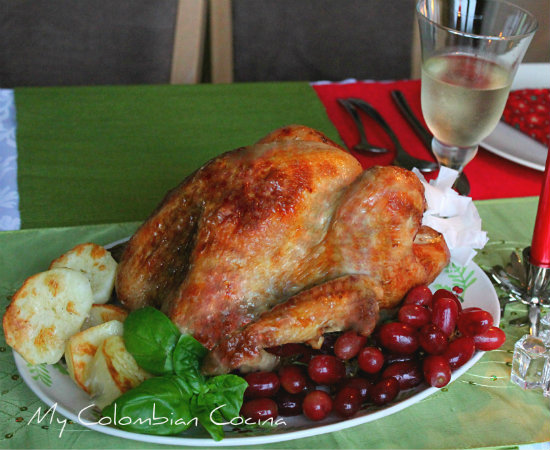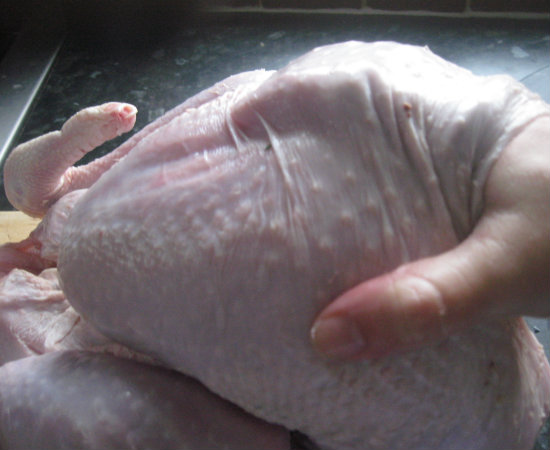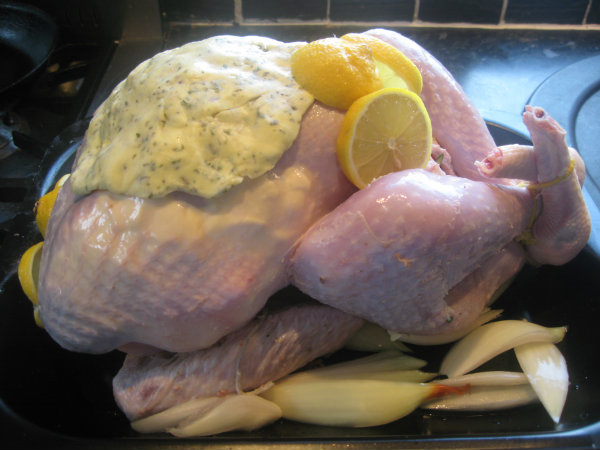Pavo Asado – Roast Turkey (English version below)
Esta receta requiere preparación anterior
Ingredientes
- 1 pavo con menudencias
- 2 naranjas
- 2 cebollas blancas
- 1/2 botella de vino blanco o una cerveza rubia
- 500 gramos de mantequilla al clima
- 1 atado de hierbas mixtas (romero, tomillo y laurel) o hierbas secas
- 2 limones
- 3 dientes de ajo
- Sal y pimienta al gusto
- 1 cucharada de harina de trigo
- Hilo para amarrar
- Papel aluminio
Preparación
- Si el pavo está congelado, colocarlo en un recipiente a descongelar.
- Luego darle una buena lavada, sacar las menudencias y el cuello.
- En un recipiente suficientemente grande colocar el pavo, 1 cucharada de sal, ajos, pimienta, un poco de hierbas frescas o secas, 2 limones en rodajas, 1 naranja en cascos con cascara. Rebosar el recipiente con agua y dejar marinar por lo mínimo por 8 horas o dejarlo hasta el siguiente día.
- El día en el que se va a cocinar, se escurre bien el pavo y secar bien. No botar las cebollas, las hierbas, y demás.
- Con mucho cuidado se introduce la mano dentro de la piel de la pechuga y la carne del mismo para abrir camino e introducir allí la mitad de la mantequilla.
- Hacer el mismo procedimiento con la parte de la rabadilla o cola.
- Sujetar las alas hacia abajo del pavo.
- Pre-calentar el horno a 180º Celsius – 350º Fahrenheit de temperatura o gas marca 4.
- Introducir en la mitad y por la rabadilla del pavo, una naranja. Esto ayudara a que el pavo se mantenga jugoso y no se seque por dentro.
- Luego amarrar cuidadosamente las piernas del pavo.
- Con el resto de la mantequilla hacer una capa y cubrir el pavo por encima.
- Las cebollas, las hierbas y el limón con los que se marino el pavo, se colocan en la bandeja para hornear para hacer una cama y no permitir que el pavo se pegue al molde. O se pueden dejar en el fondo de la bandeja y colocar encima el pavo en una rejilla para asar.
- Bañar el pavo con el vino o cerveza.
- Cubrir el pavo con papel aluminio y dejar suficiente espacio para que los vapores cocinen bien el pavo.
- Colocar el pavo dentro del horno. Cocinar por 3 horas más o menos (todo depende del tamaño del pavo, más o menos: 1 hora por cada 2 kilos de pavo)
- Después de este tiempo se destapa cuidadosamente, se baña con los jugos del mismo pavo y se coloca de nuevo al horno para dorar un poco más por encima.
- Cuando este dorado, se saca el pavo a una bandeja para servir y se deja reposar por unos minutos, tapado con el papel de aluminio, para que los jugos del pavo se distribuyan bien
Para preparar la salsa
- En una olla, colocar el líquido de la bandeja donde se horneo el pavo.
- Colocar el pescuezo del pavo y las menudencias. Dejar cocinar por 30 minutos o hasta que las menudencias estén suaves.
- Colar todo el líquido a otra olla y agregar una cucharada de harina de trigo y cocinar a fuego medio, mezclar bien hasta que espese. Salpimentar al gusto. Colocarlo en una salsera para acompañar el pavo.
- Servir el pavo, la salsa, papas rostizadas y vegetales.
Roast Turkey (English version)
This recipe requires prior preparation
Ingredients
- 1 turkey with giblets
- 2 oranges
- 2 white onions
- 1/2 bottle white wine or lager
- 500 grams butter climate
- 1 bunch mixed herbs (rosemary, thyme and bay leaves) or dried herbs
- 2 lemons
- 3 cloves garlic
- Salt and pepper to taste
- 1 tablespoon plain flour
- Hilo to tie
- Foil
Preparation
- If the turkey is frozen, place in a bowl to thaw.
- Then give it a good washing, remove the giblets and neck.
- In a roast baking tray put the turkey, 1 tablespoon salt, garlic, pepper, some fresh or dried herbs, sliced 2 lemons, 1 orange helmets with shell. Fill the container with water and let marinate for at least 8 hours or leave overnight.
- The day that you are going to cook the turkey make sure it is well drained and thoroughly dry. Do not throw away the onions, herbs, etc.
- Carefully insert your hand between the breast skin and meat and add half the butter.
- Do the same procedure with the part of the rump or tail.
- Ties down the turkey wings.
- Preheat oven to 180 degrees Celsius – 350 Fahrenheit temperature or gas mark 4.
- Put an orange in the turkey rump. This will help keep the turkey juicy and not too dry inside.
- Carefully tie the turkey legs.
- With the remaining butter, cover the turkey on top.
- Place the onions, herbs and lemon with the turkey marinade inside baking pan to make a bed to prevent the turkey from sticking to the mould. Or, they can be left in the bottom of the pan and put atop with the turkey on a roasting rack.
- Add a small amount of wine or beer to the turkey.
- Cover the turkey with foil and leave enough space for the vapours to cook the turkey.
- Place the turkey in the oven. Cook for 3 hours or so (depending on the size of the turkey, about 1 hour for every 2 kilos of turkey)
- After this time carefully uncover, bathe the turkey with its own juices and place it back in the oven to brown a little on top.
- When browned, take the turkey to a serving platter and let it stand for a few minutes, covered with foil, so that the turkey juices are distributed well.
To prepare the sauce
- In a saucepan, put the turkey juices.
- Add the turkey neck and giblets. Let simmer for 30 minutes or until giblets are tender.
- Strain all the liquid into another pot and add a tablespoon of flour and cook over medium heat, stir well until thickened. Add salt and pepper to taste. Place in a gravy boat to accompany the turkey.
- Serve the turkey, gravy, roasted potatoes and vegetables.















